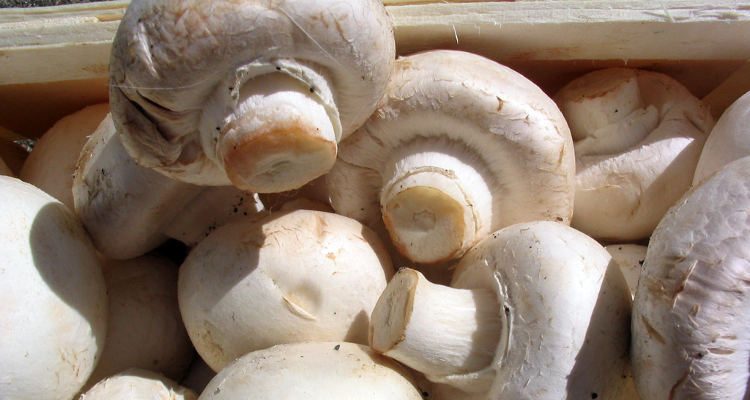
Mushrooms are the fleshy and edible fruiting bodies of fungus that appear mainly above the ground. But, do mushrooms go bad? Do mushrooms spoil? And, if so, how do we differentiate the good ones from the bad ones? Let’s find out.
Do Mushrooms Go Bad?
Mushrooms, like all other vegetables, have a shelf life. If gone bad, mushrooms can make you sick.
So, what is the shelf life of mushrooms? Sadly, there isn’t any “sell by” date, “best before” date, or “best used by” date on the packaging. To know if they are fresh or not, you will have to go with the date you purchase them.
Their shelf life depends on how you store them, how fresh were they when you purchased them, and the way you store them.
So, how long do mushrooms last or when do mushrooms go bad? Mushrooms can be stored and preserved for a long time. We’ll be covering that topic later in this article. For just an overview, mushrooms are stored whole, sliced, or cooked.
| Mushroom Types | Shelf Life in Fridge |
| Whole Mushrooms | 7 to 10 days |
| Sliced Mushrooms | 5 to 7 days |
| Cooked Mushrooms | 7 to 10 days |
How to Tell If Mushrooms Are Bad
Eating food items that have gone bad can, in the worst, scenario cause food poisoning. The common symptoms namely include bloating, diarrhea, vomiting, fever, cramping, and nausea. Eating rotten mushrooms can be risky to your health.
There is no hard and fast rule to tell exactly if the mushrooms have gone bad, but looking at their appearance and following these steps can help.
1. Check the mushrooms if they:
- Are slimy
- Have been in the fridge for two weeks or more
- Look too wrinkly
- Appear darker or have dark brown spots
- Emit a strong and noticeable odor
2. Follow these steps:
Step 1 – Examine the packaging of the mushrooms. Packaging that cuts of air circulation can slow down the spoilage process.
Step 2 – For mushrooms that are sold individually and not packaged, smelling them can help you understand if they are fresh or not. Fresh mushrooms have an earthy smell. If the mushrooms give out a sharp, vinegary, or pungent smell, it can indicate spoilage.
Step 3 – Wipe the top of the mushroom with a paper towel. Using water can speed up the spoilage process. A slimy residue means the mushrooms have gone bad.
Step 4 – Cut the mushrooms in half. Good mushrooms have a uniform color. Mushrooms with green, blue, or white spots indicate bacterial growth.
Step 5 – Check the bottom cap of the mushroom which can also reveal if they have perished. Throw away this part of the mushroom if it is soft and has a viscous texture.
Step 6 – Avoid keeping the mushrooms in the vegetable drawer. The design of these drawers keeps the moisture in vegetables intact. This is not good for mushrooms and can speed up the spoilage process.
What Happens If You Eat Bad Mushrooms?
Mushrooms, just like any other food ingredient can go bad. As mentioned earlier, if you eat them after they have gone bad, they can cause health problems.
Can you eat slimy mushrooms? No, consuming slimy mushrooms can pose some major health risks, such as food poisoning. Food poisoning can prove to be dangerous, especially to those who have a compromised immune system. Let’s take a closer look.
1. Can cause botulism
Botulism, although not very common, is fatal and caused by a bacteria called Clostridium botulinum. According to the WHO, botulinum toxins are extremely lethal. Upon consumption, this toxin is said to disrupt nerve function, resulting in paralysis.
There are various symptoms of foodborne botulism, namely paralysis, difficulty in speaking, blurred vision, difficulty in breathing, and more. The symptoms start showing from anywhere between 12 and 36 hours post the toxin’s consumption.
2. Can be contaminated with E. coli
Also known as Escherichia coli, this bacteria type is not a deadly one, but there are certain strains of this bacteria that can be harmful.
Unwashed mushrooms or the ones cleaned in unclean water can become contaminated with E. coli. The symptoms include abdominal cramps, diarrhea, nausea, and vomiting.
3. Can be contaminated with Salmonella
Salmonella affects a person’s intestinal tract. Salmonella can affect a person if the mushrooms are not cooked properly, and the situation can worsen if the mushrooms are old.
The possible symptoms after consuming salmonella-infested mushrooms include vomiting, chills, diarrhea, headache, nausea, fever, and abdominal cramps. The symptoms start showing after a few hours to two days post consumption.
How to Store Mushrooms
With so many potential health risks you may have if you consume perished mushrooms, you should know how to store mushrooms safely to avoid any spoilage. There are numerous ways to go about packing and preserving mushrooms.
1. Refrigeration method
Refrigeration is the most effective method of storing mushrooms. The maximum time you can store mushrooms using this method is a week.
Wash the mushrooms using your hands and a paper towel. Once cleaned, soak up the excess water from the mushrooms using a paper towel. Once dried, place the mushrooms in a zippered bag and refrigerate for future use.
2. Freezing method
For this method to work effectively, you need to cut the mushrooms into four pieces. Then, steam or fry them depending on your preference and taste.
If you choose to steam the mushrooms, do so for about three minutes. Put them on a plate and let them cool. Once cooled, pack them in a plastic bag or container with some space in between each mushroom and keep the bag in the freezer.
The mushrooms may turn brown, but that is due to the layer of frost around them. You can use these mushrooms for up to five or six months, or even up to a year.
3. Blanching method
Blanching means cooking something in boiling water for a while and placing it into cold water to stop it from further cooking. To blanch mushrooms, you’ll need mushrooms, water for boiling, and iced water.
First, cut the mushrooms into four pieces. Place them in boiling water, then strain and put them in the iced water. Transfer the mushrooms using a strainer into a freezer-safe container immediately. Blanched mushrooms can last for 10 to 12 months.
Conclusion
In conclusion, mushrooms are tasty and have numerous health benefits. But, if they are not stored properly or purchased without thorough checking, can cause some serious health issues. So, be sure use the proven methods above to store mushrooms for a long time and reap all the benefits they have to offer.
Related:
Sources:
“How Long Do Mushrooms Last?” Eat By Date; https://www.eatbydate.com/vegetables/fresh-vegetables/mushrooms/, last accessed June 22, 2017.
Vercillo, K., “How to Tell When Mushrooms Go Bad,” Delishably, March 16, 2016; https://delishably.com/vegetable-dishes/How_Do_You_Know_When_Mushrooms_Go_Bad, last accessed June 22, 2017.
Higgins, C., “Can I Cook With Mushrooms That Have Gone Slimy?” LEAFtv; https://www.leaf.tv/articles/can-i-cook-with-mushrooms-that-have-gone-slimy/, last accessed June 22, 2017.
Moores, D., “Botulism,” Healthline, January 28, 2016; http://www.healthline.com/health/botulism#overview1, last accessed, June 22, 2017.













